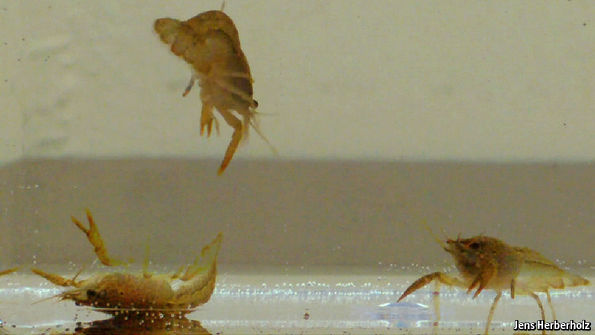Crayfish may help researchers understand drunkenness
What happens when you get a crayfish wrecked
HUMANS are not the only species to enjoy a snifter. Myriad experiments on other animals, from rats and monkeys to bees and fruit flies, show that they also get drunk, will seek out alcohol given the opportunity and may even develop a dependence on the stuff. But alcohol promotes conviviality as well as drunkenness, and that relationship is less well explored. In particular, there are few studies of whether the link is reciprocal—whether conviviality, or at least a sociable environment, affects susceptibility to alcohol. This question has, however, now been looked into. In a paper just published in Experimental Biology, Matthew Swierzbinski, Andrew Lazarchik and Jens Herberholz of the University of Maryland have shown that a sociable upbringing does indeed increase sensitivity to alcohol. At least, it does if you are a crayfish.
The three researchers’ purpose in studying drunken crayfish is to understand better how alcohol induces behavioural changes. Most recreational drugs, from cocaine and heroin to nicotine and caffeine, have well-understood effects on known receptor molecules in brain cells. That is not, though, true of ethanol, as the type of alcohol which gets people drunk is known to chemists. Ethanol’s underlying molecular mechanisms are poorly understood. But one thing which is known is that crayfish are affected by the same concentrations of the stuff as those that affect humans. Since crayfish also have large, easy-to-study nerve cells that can be examined for clues as to ethanol’s molecular mechanisms, Mr Swierzbinski, Mr Lazarchik and Dr Herberholz are using them to try to track those mechanisms down.
Their latest experiment involved 102 of the crustaceans that had each been kept for between seven and ten days in the company of several dozen others, and a further 63 that had been raised in isolation for similar amounts of time. Each crayfish was then transferred individually to a tank containing a solution of ethanol in water, and videoed for three hours to record what happened next.
As might be expected, those animals put into the most concentrated solution, 5.8% by volume, the strength of a potent beer, got pretty drunk. First, they started walking around on tiptoes. Then, they began flicking their tails and doing somersaults (see picture). Finally, the most inebriated ended up lying on their backs, kicking their legs in the air—or, rather, in the water.
Crayfish put in weaker solutions, a half or a tenth as concentrated, behaved similarly, but got there more slowly—and, in the case of those in the weakest solution, often managed to avoid the leg-kicking stage altogether. Crayfish, in other words, behave much like a bunch of roisterers out on the town of a Saturday night.
Crucially, though, when the researchers examined the videos in detail, to record what happened when, they found that, regardless of alcohol concentration, animals that had spent the previous few days in company got drunk about 25% faster than those that had been kept in solitary confinement. They therefore suspect that society makes whatever receptor molecules it is that interact with ethanol more plentiful in crayfish nervous systems than they otherwise would be. The next stage is to compare nerve cells from social and solitary animals, to try to work out what those receptor molecules might be—and then, if they can be so identified, to see if what is true in crayfish is also true in people.
The three researchers’ purpose in studying drunken crayfish is to understand better how alcohol induces behavioural changes. Most recreational drugs, from cocaine and heroin to nicotine and caffeine, have well-understood effects on known receptor molecules in brain cells. That is not, though, true of ethanol, as the type of alcohol which gets people drunk is known to chemists. Ethanol’s underlying molecular mechanisms are poorly understood. But one thing which is known is that crayfish are affected by the same concentrations of the stuff as those that affect humans. Since crayfish also have large, easy-to-study nerve cells that can be examined for clues as to ethanol’s molecular mechanisms, Mr Swierzbinski, Mr Lazarchik and Dr Herberholz are using them to try to track those mechanisms down.
Latest updates
As might be expected, those animals put into the most concentrated solution, 5.8% by volume, the strength of a potent beer, got pretty drunk. First, they started walking around on tiptoes. Then, they began flicking their tails and doing somersaults (see picture). Finally, the most inebriated ended up lying on their backs, kicking their legs in the air—or, rather, in the water.
Crayfish put in weaker solutions, a half or a tenth as concentrated, behaved similarly, but got there more slowly—and, in the case of those in the weakest solution, often managed to avoid the leg-kicking stage altogether. Crayfish, in other words, behave much like a bunch of roisterers out on the town of a Saturday night.
Crucially, though, when the researchers examined the videos in detail, to record what happened when, they found that, regardless of alcohol concentration, animals that had spent the previous few days in company got drunk about 25% faster than those that had been kept in solitary confinement. They therefore suspect that society makes whatever receptor molecules it is that interact with ethanol more plentiful in crayfish nervous systems than they otherwise would be. The next stage is to compare nerve cells from social and solitary animals, to try to work out what those receptor molecules might be—and then, if they can be so identified, to see if what is true in crayfish is also true in people.


No comments:
Post a Comment